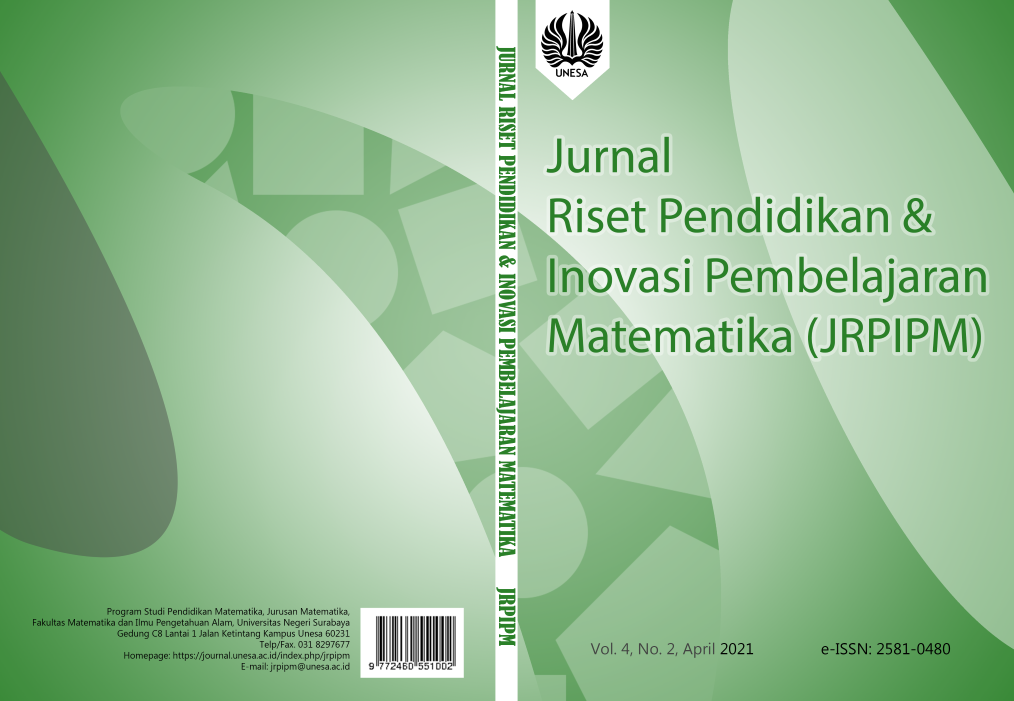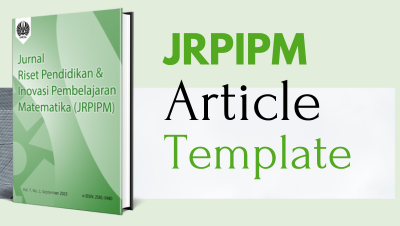The Creativity Skills of Auditory, Visual, and Kinesthetic Learners in Solving Cube and Cuboid Problems
DOI:
https://doi.org/10.26740/jrpipm.v4n2.p146-159Keywords:
Creativity Skill, Cube and Cuboid, Learning StylesAbstract
study aims to describe the creativity skills of Junior High School students in solving cube and cuboid problems based on student learning styles. The research instruments used were creativity skills tests, a learning style questionnaire, and interviews. As many as three seventh graders who have different learning styles: visual, auditory, and kinesthetic, working on a cuboid/cube problem. Their performances on such a problem were then assessed regarding fluency, flexibility, and novelty. The results showed that the visual learner produced two different solutions with two different methods/strategies and completed his solution by providing a lot of illustrations/representations although they could not be categorized as novelty solutions. Meanwhile, the auditory learner provided two different solutions with two different methods/strategies. More particularly, he determined the appropriate size and found a suitable size by using a three-variable linear equation for the cube and cuboid problem although he produced some mistakes and uncompleted on the work procedures. Lastly, the kinesthetic learner provided two different solutions with one method/strategy, such as by directly determining the various correct sizes for the problem-solution although the answers could not be categorized novelty for creativity skill. Further studies are suggested to involve more participants to get a wider insight on the students creativity for different learning styles.References
[1] Kereluik K, Mishra P, Fahnoe C and Terry L, œWhat knowledge is of most worth J. of Digital Learning in Teacher Educ., vol. 29 no. 4, pp. 127-140, 2014.
[2] Häkkinen P, et al, œPreparing teacher-students for twenty-first-century learning practices (PREP 21), Teachers and Teaching, vol. 23, pp. 25-41, 2017.
[3] Setianingsih R, œImplementasi pendekatan pembelajaran matematika realistik untuk mengembangkan keterampilan 4C siswa sekolah dasar, Proc. Seminar National Mathematics Education, Malang. pp. 524 536, 2016.
[4] Utomo E. S., Juniati D, and Siswono T. Y. E, œMathematical visualization process of junior high school students in solving a contextual problem based on cognitive style AIP, vol. 1868, 2017.
[5] Ebert M, et al, œTeaching emotion and creativity skills through art, The Int. J. of Creativity & Problem Solving, vol. 25, no. 2, pp. 23-35, 2015.
[6] Hussen S, et al, œCombinatorial thinking and creativity skills in solving a colored-square paving decoration problem, J. of Physics vol. 1211, pp. 1-12, 2019.
[7] Celik A, œThe organizational creativity skills of sports directors based on some demographic varibles, Int. J. of Human Sciences, vol. 11 no. 2 pp. 1224-1235, 2014.
[8] Isyrofinnisak F, Kusmayadi T A and Fitriana L, œMathematics creativity skill of student in junior high school based on students thinking styles J. of Physics, vol. 1538, 2019.
[9] Palengka I, Juniati D and Abadi, œCreative mathematical reasoning of prospective teacher in solving problems reviewed based on working memory capacity J. of Physics, vol. 1417, 2019.
[10] Rosidah, Budayasa I K and Juniati D, œAn analysis of statistical reasoning process of high school students in solving the statistical problem J. of Physics vol. 1028, 2018.
[11] Silver E. A, œFostering creativity through instruction rich in mathematical problem solving and problem posing, ZDM: The Int. J. on Math Educ., vol. 29, pp. 75-80, 1997.
[12] Goldin G. A, œMathematical creativity and giftedness: perspective in response, ZDM: The Int. J. on Math Educ., vol. 49, pp. 147-157, 2017.
[13] Sternberg R. J, œSchool mathematics as a creative enterprise ZDM: The Int. J. on Math Educ., vol. 49, pp. 977-986, 2017.
[14] Willing K, œLearning Styles in Adult Migration Education, Adeliade, Australia: National Curriculum Resource Center, 1988.
[15] Lujan H. L. and DiCarlo S. E, œGender differences in learning style preferences among undergraduate physiology students, Advances in Physiology Educ., vol. 30, pp. 153157, 2007.
[16] Hardaker G, Sabki A and Dockery R, œCognitive learning styles and digital equity: searching for the middle way, Int. J. Incl. Educ., vol. 14 no. 8 pp. 777-794, 2010.
[17] Messick S, œThe nature of cognitive styles: problems and promise in educational practice Educ. Psychol., vol. 19 pp. 59-74, 1984.
[18] Khodabakhshzadeh H, Hosseinnia M and Rahimian S, œLearning styles, metacognition, and creativity as predictors of the foreign language achievement, Psychol. Stud,. vol. 62 pp. 377-385, 2017.
[19] Sajedi R, œThe study of relationship between learning styles and level of creativity among students in semman university of medical sciences, Int. J. of Sci. Management and Development, vol. 2 no. 11, pp. 646-651, 2014.
[20] Chislett V. M. and Chapman A, œVAK test questionnaire, p. 1-5, September 2, 2020. [Online]. Available: https://www.businessballs.com/. [Accessed September 2, 2020].
[21] Sitar A. S, Cerne M, Aleksic D, and Mihelic K. K, œIndividual learning styles and creativity, Creativity Research J., vol. 28, no. 3, pp. 334-341, 2016.
[2] Häkkinen P, et al, œPreparing teacher-students for twenty-first-century learning practices (PREP 21), Teachers and Teaching, vol. 23, pp. 25-41, 2017.
[3] Setianingsih R, œImplementasi pendekatan pembelajaran matematika realistik untuk mengembangkan keterampilan 4C siswa sekolah dasar, Proc. Seminar National Mathematics Education, Malang. pp. 524 536, 2016.
[4] Utomo E. S., Juniati D, and Siswono T. Y. E, œMathematical visualization process of junior high school students in solving a contextual problem based on cognitive style AIP, vol. 1868, 2017.
[5] Ebert M, et al, œTeaching emotion and creativity skills through art, The Int. J. of Creativity & Problem Solving, vol. 25, no. 2, pp. 23-35, 2015.
[6] Hussen S, et al, œCombinatorial thinking and creativity skills in solving a colored-square paving decoration problem, J. of Physics vol. 1211, pp. 1-12, 2019.
[7] Celik A, œThe organizational creativity skills of sports directors based on some demographic varibles, Int. J. of Human Sciences, vol. 11 no. 2 pp. 1224-1235, 2014.
[8] Isyrofinnisak F, Kusmayadi T A and Fitriana L, œMathematics creativity skill of student in junior high school based on students thinking styles J. of Physics, vol. 1538, 2019.
[9] Palengka I, Juniati D and Abadi, œCreative mathematical reasoning of prospective teacher in solving problems reviewed based on working memory capacity J. of Physics, vol. 1417, 2019.
[10] Rosidah, Budayasa I K and Juniati D, œAn analysis of statistical reasoning process of high school students in solving the statistical problem J. of Physics vol. 1028, 2018.
[11] Silver E. A, œFostering creativity through instruction rich in mathematical problem solving and problem posing, ZDM: The Int. J. on Math Educ., vol. 29, pp. 75-80, 1997.
[12] Goldin G. A, œMathematical creativity and giftedness: perspective in response, ZDM: The Int. J. on Math Educ., vol. 49, pp. 147-157, 2017.
[13] Sternberg R. J, œSchool mathematics as a creative enterprise ZDM: The Int. J. on Math Educ., vol. 49, pp. 977-986, 2017.
[14] Willing K, œLearning Styles in Adult Migration Education, Adeliade, Australia: National Curriculum Resource Center, 1988.
[15] Lujan H. L. and DiCarlo S. E, œGender differences in learning style preferences among undergraduate physiology students, Advances in Physiology Educ., vol. 30, pp. 153157, 2007.
[16] Hardaker G, Sabki A and Dockery R, œCognitive learning styles and digital equity: searching for the middle way, Int. J. Incl. Educ., vol. 14 no. 8 pp. 777-794, 2010.
[17] Messick S, œThe nature of cognitive styles: problems and promise in educational practice Educ. Psychol., vol. 19 pp. 59-74, 1984.
[18] Khodabakhshzadeh H, Hosseinnia M and Rahimian S, œLearning styles, metacognition, and creativity as predictors of the foreign language achievement, Psychol. Stud,. vol. 62 pp. 377-385, 2017.
[19] Sajedi R, œThe study of relationship between learning styles and level of creativity among students in semman university of medical sciences, Int. J. of Sci. Management and Development, vol. 2 no. 11, pp. 646-651, 2014.
[20] Chislett V. M. and Chapman A, œVAK test questionnaire, p. 1-5, September 2, 2020. [Online]. Available: https://www.businessballs.com/. [Accessed September 2, 2020].
[21] Sitar A. S, Cerne M, Aleksic D, and Mihelic K. K, œIndividual learning styles and creativity, Creativity Research J., vol. 28, no. 3, pp. 334-341, 2016.
Downloads
Published
2021-04-30
How to Cite
A’yun, Z. Q., Juniati, D., & Ismail, I. (2021). The Creativity Skills of Auditory, Visual, and Kinesthetic Learners in Solving Cube and Cuboid Problems. Jurnal Riset Pendidikan Dan Inovasi Pembelajaran Matematika, 4(2), 146–159. https://doi.org/10.26740/jrpipm.v4n2.p146-159
Issue
Section
Articles
 Abstract views: 457
,
Abstract views: 457
, PDF Downloads: 419
PDF Downloads: 419






